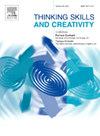The effectiveness of CPS+SCAMPER teaching mode and strategies on student creativity
IF 3.7
2区 教育学
Q1 Social Sciences
引用次数: 0
Abstract
This study explores the integration of the Creative Problem-Solving (CPS) model with the SCAMPER strategy (Substitute, Combine, Adapt, Modify, Put to Other Uses, Eliminate, Rearrange/Reverse) within the context of architectural interior design education. Seventy third-year interior design students aged 20 to 22 participated in a seven-week experimental program. The research meticulously detailed the application methods of the CPS+SCAMPER teaching model, emphasizing the comprehensive process from the inception of creative ideas to their final execution. Data collected through quantitative and qualitative research methods revealed that, compared to the control group, the experimental group exhibited remarkable improvements across four critical indicators of creativity: fluency, flexibility, originality, and elaboration. Moreover, the experimental group demonstrated notably higher enhancements in creative process evaluations and creative trait motivation assessments. The findings underscore that the combined CPS+SCAMPER teaching model and strategies significantly bolster students' design innovation capabilities and motivation. This integrated approach establishes a practical pedagogical framework for interior design education. It offers remarkable flexibility and inclusiveness, making it applicable to various design and non-design disciplines.
CPS+SCAMPER教学模式及策略对学生创造力的影响
本研究探讨了在建筑室内设计教育的背景下,创造性解决问题(CPS)模式与SCAMPER策略(替代、组合、适应、修改、其他用途、消除、重新安排/逆转)的整合。七十名年龄在20到22岁之间的三年级室内设计学生参加了为期七周的实验项目。本研究对CPS+SCAMPER教学模式的应用方法进行了细致的阐述,强调从创意开始到最终执行的综合过程。通过定量和定性研究方法收集的数据显示,与对照组相比,实验组在创造力的四个关键指标上表现出显著的进步:流畅性、灵活性、独创性和阐述。此外,实验组在创造性过程评估和创造性特质动机评估中表现出明显更高的提高。研究结果表明,CPS+SCAMPER结合教学模式和策略显著提高了学生的设计创新能力和动力。这种综合方法为室内设计教育建立了一个实用的教学框架。它提供了显著的灵活性和包容性,使其适用于各种设计和非设计学科。
本文章由计算机程序翻译,如有差异,请以英文原文为准。
求助全文
约1分钟内获得全文
求助全文
来源期刊

Thinking Skills and Creativity
EDUCATION & EDUCATIONAL RESEARCH-
CiteScore
6.40
自引率
16.20%
发文量
172
审稿时长
76 days
期刊介绍:
Thinking Skills and Creativity is a new journal providing a peer-reviewed forum for communication and debate for the community of researchers interested in teaching for thinking and creativity. Papers may represent a variety of theoretical perspectives and methodological approaches and may relate to any age level in a diversity of settings: formal and informal, education and work-based.
 求助内容:
求助内容: 应助结果提醒方式:
应助结果提醒方式:


